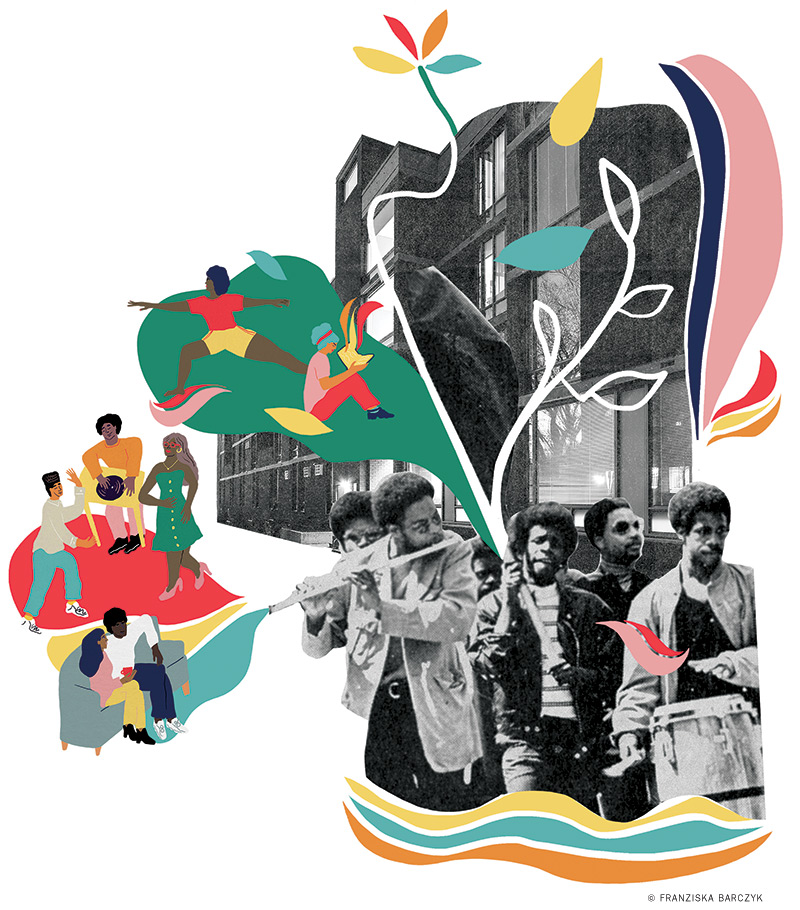
Opened in 1972 as a safe haven and a hub for Black students, Du Bois College House has overcome turmoil and undergone evolution over the last half century. Now, as it celebrates its 50th anniversary, what will the next 50 years look like for the small dormitory with big ambitions?
By Dave Zeitlin | Illustration by Franziska Barczyk
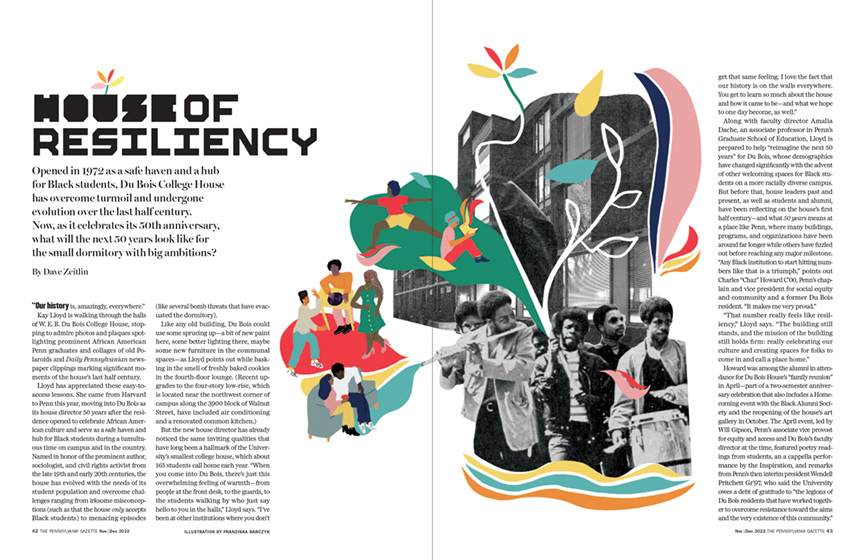
“Our history is, amazingly, everywhere.”
Kay Lloyd is walking through the halls of W. E. B. Du Bois College House, stopping to admire photos and plaques spotlighting prominent African American Penn graduates and collages of old Polaroids and Daily Pennsylvanian newspaper clippings marking significant moments of the house’s last half century.
Lloyd has appreciated these easy-to-access lessons. She came from Harvard to Penn this year, moving into Du Bois as its house director 50 years after the residence opened to celebrate African American culture and serve as a safe haven and hub for Black students during a tumultuous time on campus and in the country. Named in honor of the prominent author, sociologist, and civil rights activist from the late 19th and early 20th centuries, the house has evolved with the needs of its student population and overcome challenges ranging from irksome misconceptions (such as that the house only accepts Black students) to menacing episodes (like several bomb threats that have evacuated the dormitory).
Like any old building, Du Bois could use some sprucing up—a bit of new paint here, some better lighting there, maybe some new furniture in the communal spaces—as Lloyd points out while basking in the smell of freshly baked cookies in the fourth-floor lounge. (Recent upgrades to the four-story low-rise, which is located near the northwest corner of campus along the 3900 block of Walnut Street, have included air conditioning and a renovated common kitchen.)
But the new house director has already noticed the same inviting qualities that have long been a hallmark of the University’s smallest college house, which about 165 students call home each year. “When you come into Du Bois, there’s just this overwhelming feeling of warmth—from people at the front desk, to the guards, to the students walking by who just say hello to you in the halls,” Lloyd says. “I’ve been at other institutions where you don’t get that same feeling. I love the fact that our history is on the walls everywhere. You get to learn so much about the house and how it came to be—and what we hope to one day become, as well.”
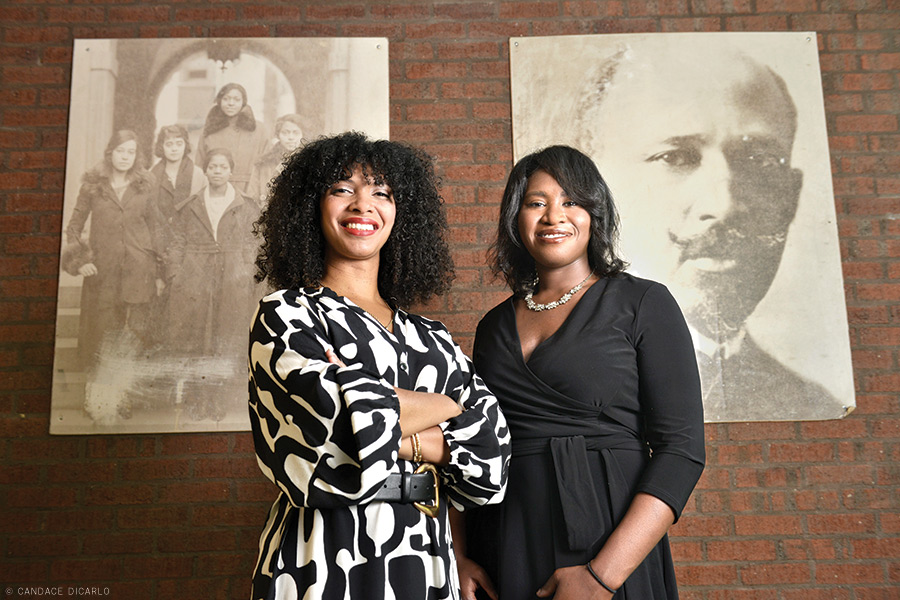
Along with faculty director Amalia Dache, an associate professor in Penn’s Graduate School of Education, Lloyd is prepared to help “reimagine the next 50 years” for Du Bois, whose demographics have changed significantly with the advent of other welcoming spaces for Black students on a more racially diverse campus. But before that, house leaders past and present, as well as students and alumni, have been reflecting on the house’s first half century—and what 50 years means at a place like Penn, where many buildings, programs, and organizations have been around far longer while others have fizzled out before reaching any major milestone. “Any Black institution to start hitting numbers like that is a triumph,” points out Charles “Chaz” Howard C’00, Penn’s chaplain and vice president for social equity and community and a former Du Bois resident. “It makes me very proud.”
“That number really feels like resiliency,” Lloyd says. “The building still stands, and the mission of the building still holds firm: really celebrating our culture and creating spaces for folks to come in and call a place home.”
Howard was among the alumni in attendance for Du Bois House’s “family reunion” in April—part of a two-semester anniversary celebration that also includes a Homecoming event with the Black Alumni Society and the reopening of the house’s art gallery in October. The April event, led by Will Gipson, Penn’s associate vice provost for equity and access and Du Bois’s faculty director at the time, featured poetry readings from students, an a cappella performance by the Inspiration, and remarks from Penn’s then interim president Wendell Pritchett Gr’97, who said the University owes a debt of gratitude to “the legions of Du Bois residents that have worked together to overcome resistance toward the aims and the very existence of this community.”
For Howard, who also spoke at the event, the fact that Penn’s first Black president marked the occasion—even if Pritchett only served in that role for less than five months to bridge the gap between Amy Gutmann Hon’22 and Liz Magill—showed how far Penn has come since the house was founded, in an era when efforts to recruit any Black faculty were only just beginning to take hold. Noting that his grandfather was friends with W. E. B. Du Bois, Howard postulated that if Du Bois were still alive today, “he would be stunned and proud that the president of the University of Pennsylvania is a Black man.”
“Don’t ever take that for granted,” Howard continued, to applause from the audience. “It’s a big deal.”
‘COMPLEXITIES TO THIS BEAUTIFUL STORY’
Although Penn admitted its first African American students in 1879—as documented on the walls of Du Bois—the University remained an extremely white institution for most of the next 90 years. It wasn’t until 1967, when Penn changed its admissions policy to increase the recruitment of minorities, that the status quo began to change. Between 1966 and 1969 the number of Black students entering Penn more than tripled, from about 40 to 140.
Yet the admissions shift created a new problem. “At the time, a big concern was the retention rates of Black students,” Gipson says. “Word on the street was that someone would be there one semester and the next semester they’d be gone, and a lot of times people didn’t know what had happened to them.”
An article in the Gazette’s December 1969 issue, titled “Black Student Needs: Pennsylvania’s Response,” painted it as a trend that transcended Penn, suggesting that a “significant increase of black undergraduates at predominantly white institutions” was spurring a nationwide reckoning. “A new vocabulary has emerged on the campus, drawing attention to the ‘felt needs’ of these students both in a social and academic sense,” the Gazette’s Ellen James wrote, highlighting plans at Penn for the creation of a modest Black social center as well as an early iteration of what would become the Africana studies department (which also recently marked 50 years).
But a Black student named Cathy Barlow CW’71 L’76 believed more was needed. “I was watching a lot of my friends and contemporaries fail,” Barlow told the Gazette 10 years ago during Du Bois’s 40th anniversary celebration [“Gazetteer,” Mar|Apr 2013], recalling instances of harassment from police and indifference from white professors. “Just admitting Black students wasn’t enough—it isn’t meaningful enough. What’s truly meaningful is those students getting their degrees.” As a sophomore, Barlow helped plan a sit-in at College Hall for a variety of progressive demands. She also earned a research grant from the provost’s office to create a Black Studies Commission that examined what other colleges were doing to address retention and graduation rates among African American students. Discouraged by the “largely superficial” initiatives she found—“little more than environments for Black students to socialize and hang out together”—she envisioned something bigger for Penn: a residential program that could foster true connection, mentorship, and academic success among Black peers. In February 1972, she and other student leaders proposed to University administrators such a residence for about 120 students, along with advisors and faculty members, that “was to be a learning environment with a course taught on site, a speakers’ forum, library, film series, and ‘independent community study’ courses,” wrote Wayne Glasker C’80 Gr’94 in his 2002 book Black Students in the Ivory Tower: African American Student Activism at the University of Pennsylvania, 1967–1990. “The program would focus on Afro-American culture and the counseling needs of students. This was very different from a nonresidential social and recreational center.”
In a Daily Pennsylvanian article on March 8, 1972, about the “controversial black residence proposal” being brought up for debate at a University council meeting, Penn President Martin Meyerson Hon’70 offered what seemed like a reluctant nod of approval for the proposal as an experimental living and learning program, saying, “I recognize how very unhappy many of the Black students are and I am awfully sad they have not found in the range of choices offered by the University, the satisfaction they want.”
On August 31 of that year, the W. E. B. Du Bois Residential Program was launched on the first two floors of Low Rise North, which had been built the prior year (and was officially named Du Bois College House in 1981), with Barlow serving as the inaugural administrative director. But the debate surrounding its existence continued to swirl.
Even though Barlow and others said from the start that the residence would be open to students of all races, “the impression that Penn had approved a ‘black-only’ facility proved exceedingly difficult to rectify,” wrote Glasker, a professor of African American and 20th century US history at Rutgers University [“Safe Places,” Nov|Dec 2002]. And while the admission of a few white students in those early years helped to fend off litigation over issues of discrimination, Du Bois “remained the object of criticism and hostile scrutiny,” Glasker added. Detractors—including not only faculty and students but the American Civil Liberties Union and the NAACP—lamented the perception of self-segregation after the hard-earned achievement of integrating elite universities.
Those laments have persisted through much of the last 50 years, often in the form of Daily Pennsylvanian editorials, but so has Du Bois, which “stands as a testimony to the enduring desire of African American students at Penn to preserve their own culture and autonomy,” Glasker wrote. The fact that the NAACP and other Black leaders “didn’t want them to do it because they viewed it as a separatist effort adds complexities to this beautiful story,” Gipson reflects. “Nevertheless, the students forged a legacy here at Penn that really matters to a lot of folks.”
‘THERE WAS ALWAYS SOMETHING HAPPENING’
“I will really lose it if I see that dorm blow up.”
So said the late Claire Lomax C’84 [“Obituaries,” Sep|Oct 2022], a former attorney and Penn trustee, in a University-commissioned video about diversity at Penn. Recalling a bomb threat that evacuated Du Bois during her sophomore year in 1981, Lomax said she was “so scared”—and underwhelmed by the spectacle of her housemates singing “We Shall Overcome” outside the building. That “rang a little hollow to me at that point. I just felt it was really shameful we had to still endure that type of racism—overt racism.”
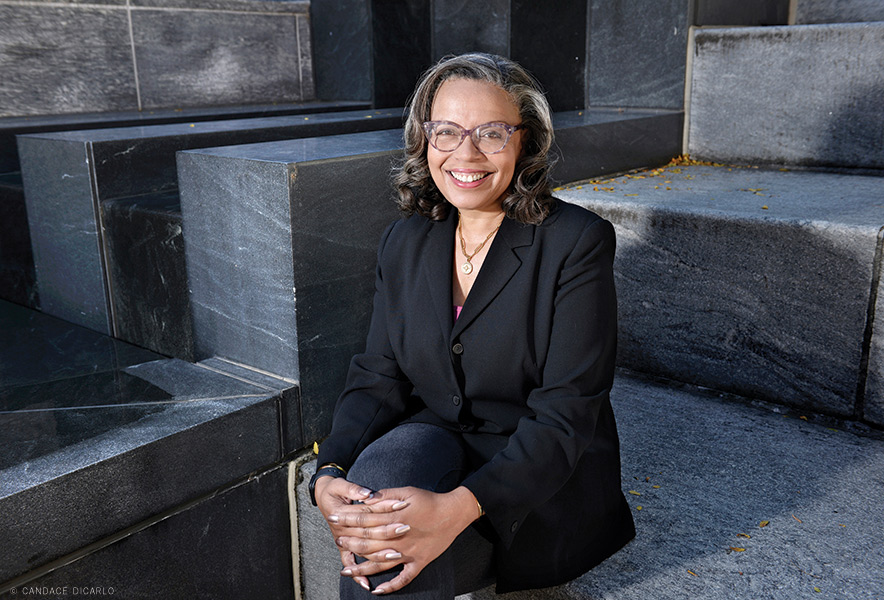
Sadly, that wouldn’t be the only bomb threat or racially harassing phone call made to students inside the building. Sonia Elliott C’88 GEd’01, a former resident and house dean at Du Bois and the current house director at Ware College House, and Brian Peterson EAS’93 GEd’97 Gr’13, who lived in Du Bois for nearly 10 years as an undergrad and graduate associate and now serves as the director of Penn’s Makuu: The Black Cultural Center, both recall different instances of phoned-in bomb threats clearing the building and the feelings of panic and confusion that ensued. So does Chaz Howard, who lived there for three years as an undergrad in the late 1990s. “There’s a bomb in the building. I’m gonna blow all you n-words up,” is what Howard was told the person on the other line said. “We had heard about it happening before, so it wasn’t a surprise,” the Penn chaplain continues. “It happens, we go back in, we roll our eyes, and we keep moving on and we go to class the next day.”
For Howard, the feelings of warmth and friendship far outweighed any negatives. As a freshman, he was homesick but quickly found brotherhood with his three suitemates, enjoying the house’s suite model that combined a common space with private bedrooms and bathrooms. “There’s also something nice about a four-story spot where you can feel like you know the whole building and, by the end of the year, almost every face that comes through,” he says. When his dad died at the end of the first semester of his freshman year, Howard recalls, practically everyone on his hall spent time with him in his suite. “I’ve never forgotten that, the way they were there for me 26 years ago,” Howard says. “It’s a beautiful memory.”
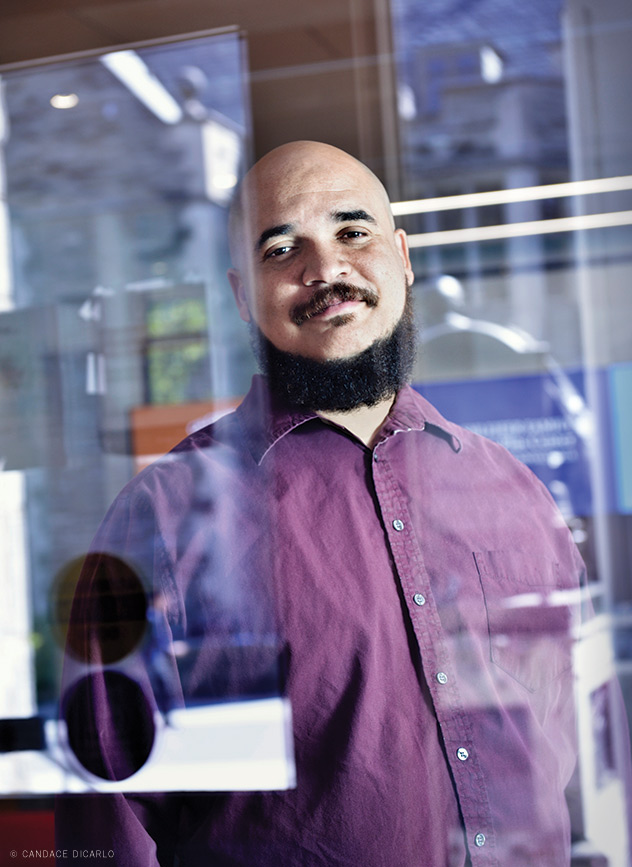
There are others. From Valentine’s Day lunches, to banquets in the first-floor Multi-Purpose Room, to rappers and other artists stopping by while on tour, “it was a very lively spot,” Howard says. “There was always something happening.” The Du Bois Bowl, for instance: a series of rough-touch football games played on the patch of grass near 40th and Walnut Streets (where Gutmann College House now stands). “People loved to beat up on the freshman team,” Howard laughs. Peterson, who served as league commissioner for a time, recalls its competitive edge, with stats tracked along with standings and even some former Penn football players participating. “You would be sore Monday—and Tuesday,” says Peterson, adding there was a weekend study hall that went with the football league, which at its peak had up to 10 teams. “But it really built family. It kept some people at Penn—literally. Particularly at that time, with fewer Black men on campus, it was something that really held us together.”
Those football games were only part of the reason that Peterson never wanted to live anywhere else while studying at Penn. There were plenty of other activities he enjoyed (like trading hip-hop cassette tapes with hallmates) and he also felt a certain sense of responsibility. “There were a lot of upperclassmen who lived there and took us under their wing and made sure we knew how to navigate Penn,” says Peterson, who in addition to running Makuu is currently a lecturer in Penn’s Africana and urban studies departments. “I became one of those people over the years. I wanted to do for the first-year students coming in after me what those juniors and seniors did for me.”
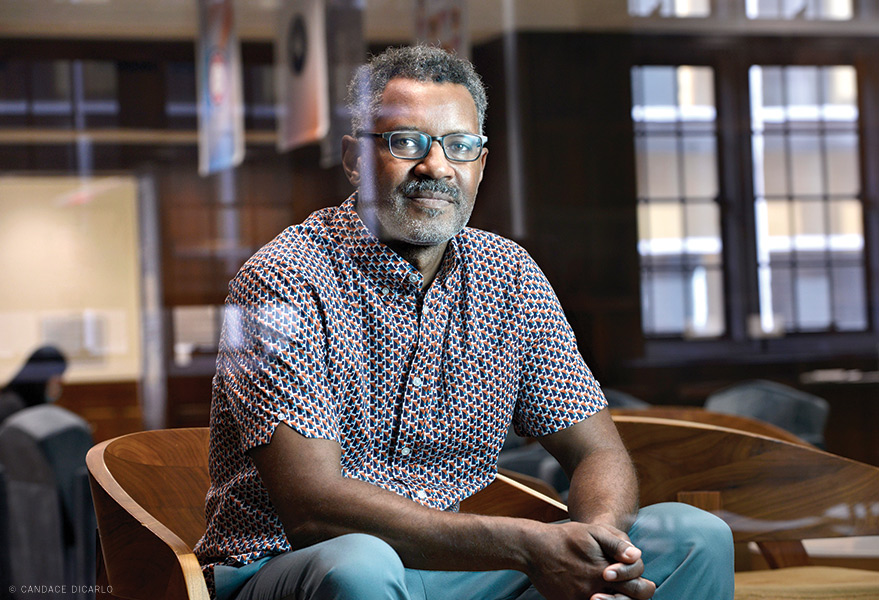
The large Multi-Purpose Room, commonly called MPR, became the source of many of Peterson’s fondest memories—from trying to get a glimpse of the civil rights activist Julian Bond teaching a class there during a pre-freshman visit, to lobbying Elliott to reserve time there for the community outreach programs he ran as a graduate student. “It was just a hub for everybody,” Peterson says. “It didn’t matter if you were a resident or not.” Elliott says that when she was working as Du Bois’s house dean from 1995 to 2001, “my joke used to be you never knew who lives there because everybody considered it home.” (That was her undergraduate experience; she only officially lived in Du Bois as a freshman but was there just about every day for the next three years.)
“To me, it didn’t feel like some of the other resident spaces felt,” says Elliott, who worked at other schools and colleges for the last 20 years before returning to Penn this year to be Ware’s house director. “It definitely had a different kind of purpose.”
Given its roots in African American activism, one purpose was as a hub for brainstorming about improving the Black experience on campus. “It was always kind of the center of triumphs and challenges on campus,” Elliott notes. And, she adds, those conversations had a way of happening organically, without direction from administrators.
“We’ve had a diverse Black community, not a monolith,” Howard says. “Some people are like ‘Fight the power.’ Some people are bookworms whose revolutionary act is graduating magna cum laude.”
Just as W. E. B. Du Bois himself might have wanted.
‘THIS IS HOME’
Discussing why she hoped to become the faculty director of Du Bois College House, as she did this year, Amalia Dache starts by referring to herself as a “Du Boisian.”
“I was always rooting for Du Bois’s arguments that it was intellectual excellence, intellectual cultivation for the Black community that will lead to change,” instead of Booker T. Washington’s “more Southern perspective” that Blacks first needed to focus on economic advancement and not higher education in the early 1900s, Dache explains. As an Afro-Cuban immigrant, first-generation college student, and scholar who researches the college-access experiences of African diasporic students and communities, “the great equalizer of education was something I always believed in,” continues Dache, who cites Du Bois’s seminal 1901 sociological study The Philadelphia Negro in her research at Penn GSE, where last year she became the first tenured Latina professor. “So when I got the opportunity to apply for this position, I said, ‘Oh, this is right in my wheelhouse.’ Being at Du Bois is just so central in my work, and also the vision of the University and my vision for scholarship.”
Now Dache hopes to use that scholarship to push Du Bois House into the next half century. Pointing out that the dorm’s leadership is mostly new, “it really feels like this is the beginning of another transition for Du Bois College House,” she says. Faculty fellow Audrey Mbeje is expanding the house’s Zulu in Residence program, which exposes students to the language and culture of the Zulu people of South Africa, while another faculty fellow, Jack Drummond, is continuing a tutoring initiative in West Philadelphia public schools. “It gives you a breadth of the African diaspora within the house,” Dache says. Meanwhile, Dache has started a Spanish language immersion experience on Fridays called Cafecito, complete with Cuban coffee and pastries from a Latino bakery, and has worked to expand the house’s Amistad Gallery to highlight more global art. She and Lloyd also hope to add more research-related programs featuring visiting faculty fellows and to restore the Souls of Du Bois conference, which is named in honor of Du Bois’s The Souls of Black Folk: Essays and Sketches. (Although a plaque by the house entrance quotes a line from this 1903 book, Du Bois had a complicated relationship with the University, where he taught classes and conducted research that would lead to The Philadelphia Negro but was never offered a professorial appointment. Penn tried to make symbolic amends 10 years ago by posthumously bestowing him with an emeritus professorship in sociology and Africana studies.)
“I think it’s going to become a house that students know will have strong scholars visiting,” Dache says, “with artwork that represents up-and-coming photographers and artists from across the African diaspora.”
Before crafting future plans, Dache talked to previous house directors, including Gipson and her GSE colleagues Howard Stevenson (who served in that role from 1994 to 2002) and Valarie Swain-Cade McCoullum (1978–1980), to “build off their visions and hard work over the last 50 years.” They emphasized the importance of in-house tutoring, support for student-based research projects, and continuing to embrace the family nature of the four-year house—which is something that doesn’t go away after graduation.
Among Elliott’s proudest accomplishments as house director was reengaging Du Bois alums “and getting them to fall in love with the house again,” which led to the formation of an endowed scholarship fund to provide financial assistance to residents as well as alumni-student mentoring programs. She’s also remained close with many former Du Bois students, who are now “doing everything from serving as educators to running corporations,” Elliott says. “The one common denominator is there’s always love for Du Bois, and that love is there whether they officially lived in the house or not.” Peterson has similarly enjoyed watching his old housemates move on to big things, from Pulitzer Prize winner Salamishah Tillet C’96 G’04 to spirits expert OJ Lima C’94, and he remains close with his current Penn colleagues Stevenson, Elliott, and Howard.
Older alums who return to Du Bois are apt to notice a greater percentage of residents who don’t identify as African American. Although that kind of diversity has existed for decades, it has steadily increased with the advent of other places for Black students like Makuu, which was founded in 2000 as a comfortable space for students of the African diaspora to gather, and the African-American Resource Center. “I want our students to live where they want to live,” says Howard, adding that compared to the 1970s, today’s Black students are more likely to come from, say, a prep school and feel more comfortable living in majority white spaces. “And I love that non-Black students want to live in Du Bois,” Howard continues. “We’ve raised a generation that’s more progressive.”
“Everyone should have a choice,” adds Peterson. “If people think they want to live in a space celebrating Black culture, that’s their choice, no matter who that person is.” Dache attributes the shifting demographics to “Penn and their college houses doing a really good job of making students across racial lines feel safe and providing spaces where they can thrive.” And she also points out this trend has extended beyond Penn, even to historically Black colleges and universities (HBCUs), which have seen a rise in the enrollment of white and Hispanic students. “The demographics changing means more opportunities, more options—which is a good thing,” she says.
Not everyone agrees. Sophomore nursing student Djine Mentor, who grew up in Haiti, was surprised to see that her floor was less than half Black when she moved into Du Bois this semester, echoing a concern other Black residents shared in a Daily Pennsylvanian article last April. “I know the housing application doesn’t take race into consideration, but I feel like it also erases the whole purpose of having Du Bois College House,” Mentor says. “Fifty years from now, what will happen? I just feel the number [of Black students] will keep on being less and less. … It’s still our home but will it be the home of the upcoming generation? Fifty years from now, will it still be the same?”
Yet Mentor has still enjoyed living in Du Bois, and when discussing her favorite aspects of dorm life, brings up many of the same welcoming qualities that have been touchstones for the last 50 years—from working out with her suitemates in their “huge living room” to baking in the community kitchen to studying, admiring art, and hanging out with friends in the MPR, Paul Robeson Library, Sonia L. Elliott Recreation Room, and other tucked-away spaces. And her reasons for choosing Du Bois echo those of residents of previous eras, too.
“I don’t think people realize that it can be really hard being away from home, especially when you have to worry about walking into a classroom and being the only Black student there,” Mentor says. “I feel like that’s a lot. And I feel like knowing you have that space where people relate to the stuff you’re going through makes such a huge difference—emotionally and mentally.”
And so, as Du Bois marches into a new half century, its mission largely remains the same. Elliott for one is grateful that Penn has grown as an institution so that the “entire weight” of being a hub for Black students no longer rests solely on Du Bois, and that the house “can now share in those efforts with Makuu and other spaces that can function in partnership.”
“Du Bois is lucky enough to have this amazingly powerful history, but what’s also nice about Du Bois is that it can continue to change and grow and evolve,” she says. “It’s not this thing that needs to be stuck in time and place.”
“Fifty years—what does that mean?” Elliott continues. “It just means hoping for 50 more years for Du Bois. And 50 years after that. I hope it continues to be an institution in terms of supporting communities and supporting students.”
Perhaps Howard put it best at the anniversary celebration in April when he reflected on the last 50 years and called on people to continue loving Du Bois for the next 50 and beyond. “This is home,” Howard told the familiar faces who once lived in the building with him and have forever remained linked. “It’s not a dorm. It’s a home.”




